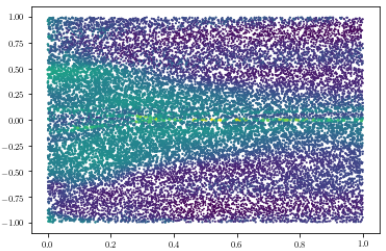Self-Adaptive PINNs using a Soft Attention Mechanism
Additionnal learning of multiplicative soft attention masks to weight each training point individually
Context: PINNs may not fit the residual/boundary/initial conditions in “rapidly varying regions” depending on the PDE.
Proposed solution: The neural network learns which regions of the solution are difficult and is forced to focus on them. The self-adaptation weights specify a soft multiplicative soft attention mask, like the one used in computer vision. Each data point is associated with its self-adaptation weight. More formally, they are trainable, nonnegative self-adaptation weights for the initial \(\boldsymbol{\lambda}_0\), boundary \(\boldsymbol{\lambda}_b\), and residue points \(\boldsymbol{\lambda}_r\), respectively. The corresponding objective loss reads
$$ \begin{equation} \mathcal{L}\left(\boldsymbol{w}, \boldsymbol{\lambda}_r, \boldsymbol{\lambda}_b, \boldsymbol{\lambda}_0\right)=\mathcal{L}_s(\boldsymbol{w})+\mathcal{L}_r\left(\boldsymbol{w}, \boldsymbol{\lambda}_r\right)+\mathcal{L}_b\left(\boldsymbol{w}, \boldsymbol{\lambda}_b\right)+\mathcal{L}_0\left(\boldsymbol{w}, \boldsymbol{\lambda}_0\right) \end{equation} $$
Both the neural network parameters \(w\) and the self-adaptation weights are learned as follows
$$ \begin{equation} \min _{\boldsymbol{w}} \max _{\boldsymbol{\lambda}_r, \boldsymbol{\lambda}_b, \boldsymbol{\lambda}_0} \mathcal{L}\left(\boldsymbol{w}, \boldsymbol{\lambda}_r, \boldsymbol{\lambda}_b, \boldsymbol{\lambda}_0\right). \end{equation} $$
- Cons:
- 3 hyperparameters per training instance + one learning rate
- Max? A bit heuristic
- Need to always use the same colocation points
Proposed solution (SGD): extension to handle varying colocation points. The basic idea is to use a spatial-temporal predictor of the value of self-adaptive weights for the newly sampled points. Resort to a Gaussian process.
Other previously proposed solutions:
- Non-adaptive Weighting
: put premium in the loss for the initial - Learning Rate Annealing
: the weights are learning rate coefficients that change for each epoch according to statistics calculated using the data of the back-propagation - Neural Tangent Kernel Weighting
: based on the evolution of the eigenvalues - Mimimax Weighting
: update the weights during training using gradient descent for the network weights, and gradient ascent for the loss weights, seeking to find a saddle point in weight space.
